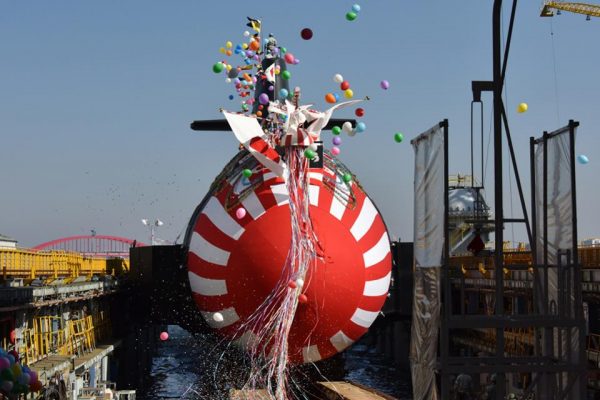Japanese Navy May Have Gained Tactical Edge With First Lithium-Ion Battery Submarines – Forbes
In a ceremony on November 6, Japan launched its latest submarine, the Toryu, its second to be equipped with lithium-ion batteries. Japan is the first country to field this game-changing technology in submarines.

The launch ceremony of the submarine Toryu, November 6.
Japanese Maritime Self-Defense Force
So what is the big deal? We are familiar with lithium-ion batteries in our smartphones, laptops and other consumer goods. They have a higher power-density than traditional batteries, and they can be made smaller and in novel shapes which better fit the space given to them. Yet the submarine community has been slow to adopt this technology.
This is for good reason. As we know from Samsung’s woes with the Galaxy Note 7, lithium-ion batteries are prone to catching fire. Battery fires aboard submarines can quickly turn lethal. Recently 14 elite Russian submariners lost their lives due to a fire in the battery compartment of their submarine. Those were traditional, safer, lead-acid batteries. Japan must have found a way to make lithium-ion batteries safe enough to send to sea.
The first 10 Soryu class boats used traditional heavy duty acid batteries like almost every other submarine in the world. Even nuclear submarines have a bank of lead-acid batteries as back up.
But the Japanese submarines also have an Air-Independent Power (AIP) system. This uses closed-cycle ‘Stirling’ diesel engines to generate electricity to turn the propeller while the submarine is submerged. This means that submarines can patrol longer without surfacing, thus preserving their stealth. AIP is itself seen as cutting edge technology so it’s telling that Japan has stepped beyond this with lithium-ion batteries.
South Korea is also planning to adopt lithium-ion batteries for their future submarines. Their latest Jangbogo-III class boats are already among the most well armed non-nuclear submarines in the world.
Japan’s next generation ‘29SS’ submarine may abandon AIP altogether and rely on a large bank of lithium-ion batteries. The advantage of pure lithium-ion batteries over AIP is power: so far AIP has never provided enough power to propel a submarine at full speed underwater. For this submarines anyway resort to their batteries. And the AIP is not powerful enough to recharge the batteries so the old-fashioned diesel generator is still required for that. Additionally AIP systems require dangerous substances to run, typically liquid oxygen and hydrogen.
So AIP enhances the stealth of a submarine, its key characteristic, but at the cost of size, complexity and maintenance. An AIP submarine still needs a diesel generator and still needs a large bank of batteries. Most navies see the trade-offs as worth it, but lithium-ion batteries promise to change this equation. Having barrier batteries removes the need for the AIP, thus making the submarine smaller and easier to maintain.






